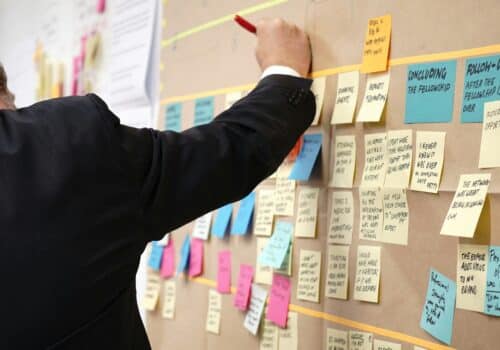The Future of ERP: Why DOP Is Where Manufacturing Is Headed
What is the future of ERP? Over the decades that I’ve spent helping companies get the most out of their ERP systems, business processes, and people, I’ve seen a lot of technology trends come and go. But there’s something new on the horizon that I think is going to be a game-changer for many of the mid-sized, family-owned manufacturing companies that my team and I work with: Digital Operations Platform (or DOP for short).
Recently I sent out an email to the Syte newsletter list talking about this concept, and I received such a positive response, I knew it was time to explore this at greater length in an article.
I believe DOP is where ERP is headed in the next ten years (Forrester thinks so too). Here is why it’s so important for your company’s future growth …
DOP Is the Next Evolution of ERP — Without the Baggage
You may be wondering, “Why would I need yet another software application on top of what we’re already using?” But DOP is so much more than a software application — it’s the next-level technology that brings together your ERP and all of your other existing technology and processes.
DOP is a centralized ecosystem that brings all of your systems and processes together under one umbrella.
Your ERP is a powerful tool, but on its own, it isn’t enough to get you to where you need to go. For next-level business intelligence and analytics — the kind you need in order to remain competitive — you have to get your people, business processes, technology and industrial equipment all working together.
The result? More robust and complete data that allows you to achieve performance improvements you couldn’t achieve otherwise.
Think of it like a car: ERP is the engine, but it can’t get anywhere on its own. DOP is the car’s body that holds everything together, so that every part — the tires, the engine, the exhaust system — can work in tandem to reach the final destination.
For example, a DOP could enable you to automate a purchasing workflow that gets triggered by an inventory count threshold, and that inventory data is updated in real-time through barcode scanning operations on the warehouse floor.
That is the power (and the promise) of DOP.
Common Roadblocks to Manufacturing Innovation
For mid-size manufacturing companies, I see a lot of the same challenges come up again and again when it comes to modernizing their operations for growth.
First, there’s inertia. A lot of manufacturing businesses are still running on an “old school” model. They’re doing things the same way they were doing them twenty years ago — and that’s usually accompanied by some old ways of thinking too. Resistance to change can be a pretty powerful obstacle, but it’s not insurmountable.
Second, there’s lack of integration in the back end. The existing ERP may support a lot of business processes that they can’t leverage because other tools and systems aren’t set up to work in tandem and take advantage of that more sophisticated functionality. So it becomes a bit of a waiting game — they postpone innovating on their processes and workflows until all the disparate technical pieces come together.
Third, there may be a lack of resources (capacity, capabilities or both) that precludes a “forklift upgrade” to get everything done at once. This is completely understandable, and it’s why having a roadmap and clarity on What Matters Most (WMM) to your organization is so critical to success.
Charting Your Course to DOP
Obviously, you’re not going to move to a full-fledged DOP overnight. It’s a big project, and it should not be undertaken lightly. But it is the conversation you’re going to have, eventually.
Depending on where you are in your business evolution, a path to DOP could look something like this:
- Select, implement and optimize your ERP for your current business processes. This has the benefit of forcing you to start where you are, with what you have, and evaluate the business processes and workflows you’re currently using. Business process mapping can give you critical insight into what’s working and what isn’t.
- Conduct an Industry 4.0 Assessment. Here, you need to take an honest look at how ready you are to embrace the world of digital manufacturing. Are you already leveraging the Internet of Things (IoT) in your manufacturing operations? Where could you invest more in smart manufacturing operations?
- Develop an Operational Intelligence (OI) Framework. This is your roadmap, and it should be aligned with your resources, company culture, your industry and, of course, your business priorities.
- Put together and execute a Smart Manufacturing Operations Management (MOM) strategy. This brings together your Manufacturing Execution Systems (MES) and digital technologies into a single ecosystem. But don’t worry — this will take place over time.
The Future of ERP Is Right Around the Corner
I’m excited about all of the possibilities that DOP is opening up for family-owned manufacturing companies. So many are ripe for this kind of innovation and poised to reap all of the rewards of the future of ERP.
So what’s next for your company? With so much of our world gone virtual seemingly overnight, there’s never been a better time to think about how you’re going to evolve your business. I’d love to help get you started. Schedule a one-hour complimentary collaborative consulting sessions and we’ll start by identifying where you are on your ERP journey, then lay the groundwork to get ready for what’s next. Schedule your time right here.
ERP Readiness Self-Assessment
Is your organization ready for a new or upgraded ERP solution? Find out with this complimentary self-assessment.
Doing Business Better
You strive for excellence, believe in your people, and want to do things right the first time. And you know that you need help to get to the heart of your business challenges and make the best choices for the future of your privately held manufacturing and distribution company. That’s where we come in.
We help you focus and find exactly the right path to accelerated growth and sustainable success — from your people to your processes to your ERP software.



